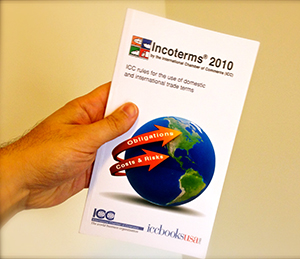 My exposure to Incoterms goes back to 2002 when I took my first FITT-accredited international business course at Seneca College. The industry was already adapting to Incoterms 2000, and I still remember the stress I felt while studying for my tests trying to memorize all thirteen terms at that time.
My exposure to Incoterms goes back to 2002 when I took my first FITT-accredited international business course at Seneca College. The industry was already adapting to Incoterms 2000, and I still remember the stress I felt while studying for my tests trying to memorize all thirteen terms at that time.
Although I had already been working for a few years in the industry by then, these terms were a new area of international business to which I had not been exposed academically.
Walking my first steps into the world of Incoterms
When I started my career in supply chain and logistics, my first job was dealing with exports. The company I worked for manufactured car parts for aftermarket applications. Although my title was customer service, I had to wear several different hats, one of which had me preparing export documentation for a number of global accounts.
The Incoterms® 2020 online course, presented by the Forum for International Trade Training (FITT) and the Canadian Chamber of Commerce (CCC), will get you up to speed on the new Incoterms® 2020 rules and help you succeed in global markets. You can take the course anytime, from anywhere. By successfully completing the course, you’ll earn the Incoterms 2020® Training Certificate. This online course is offered in partnership with the Canadian Trade Commissioner Service (TCS) and Export Development Canada (EDC).
I kept seeing these Incoterms all over the documentation I was preparing for my customers, but I knew very little about what each of the terms really meant. This was not because I wasn’t interested in learning at that time, but because of time constrains during work hours.
Those of you working in manufacturing, logistics and supply chain know that this career is fast-paced. This is one of the main reason why I wanted to explore my educational options, and that’s how I ended up in the FITT-accredited program at Seneca.
Don’t mistake FOB for F.O.B.
Free on Board, or simply FOB, is a commonly used Incoterm. Unfortunately, it is also one of the terms that is most commonly confused. Let’s first discuss how it has been misused.
During my career, not only as a Certified International Trade Professional (CITP), but also as a faculty member teaching international business topics at different colleges, I have seen over and over how FOB is mistaken with F.O.B.
You might be wondering what and where the confusion originates. Back in the days when truck’s bills of lading used to be pre-printed, one of the fields to complete was ‘Freight on board’ or F.O.B. (note the periods in this acronym). This was particularly evident in shipments originating within North America, where the confusion between FOB and F.O.B. led to this misunderstanding.
Back in September 2010, I attended the International Chamber of Commerce (ICC) Incoterms train-the-trainer session in Chicago. One of the mandates from the ICC was to make sure that industry practitioners adopted the use of Incoterms 2010. Besides the reduction from thirteen terms to eleven terms, one of the biggest changes was the redefinition of the FOB term. It has now been revised and can only be used for ocean transportation.
Where the risk transfers from seller to buyer
The first statement when it comes to FOB references that “this rule is to be used only for sea or inland waterway transport” (ICC). By utilizing FOB, the seller ships and “delivers the goods on board of the vessel nominated by the buyer at the named port of shipment” (ICC).
In plain language, this means the seller will contract a carrier to first move the goods from their warehouse and into the port facility. Pre-carriage is basically pre-paid, and it includes costs such as the loading of the shipment into the vessel.
When I teach FOB to my students, I usually show an image of a crane collapsing and dropping a container into a vessel. Then, I ask, who is at risk in this situation when utilizing the term FOB?
Under this term, the delivery of the goods happens when the seller places the goods on board the vessel. This is the exact moment where risk has been transferred from the seller to the buyer.
Some frequently asked questions about Incoterms
 Many of the following questions were asked to me by a group of my current students. Hopefully my answers will be able to clear up some areas of confusion for you as well!
Many of the following questions were asked to me by a group of my current students. Hopefully my answers will be able to clear up some areas of confusion for you as well!
Is it possible to amend an Incoterm to suit a special situation?
Although a contract has already been signed, usually amending an Incoterm is not recommended. However, this is how I have dealt in the past. I would price the order with the ‘amended’ Incoterm, and request that the buyer issue a new PO showing the new pricing and Incoterm to be used.
What is the difference between CIP and CIF? What about the risk, costs and obligations for both parties? Who pays the unloading fees under ‘C’ terms?
Both Incoterms allow the seller to handle the shipment from origin to place of destination. If the Incoterm used is CIF, the shipment will be arranged via ocean transportation. The seller arranges the shipment to arrive to a port of destination specified by the buyer.
One critical point in these two terms is that “risk passes and costs are transferred at different places” (ICC). Although the cost includes the pre-carriage and main carriage paid by the seller to destination, the risk passes from the seller to the buyer when the goods are delivered to the transportation carrier doing the “main carriage”. As an example, under CIF, this will be the actual vessel.
The buyer is always responsible for all unloading fees unless there is a special condition in the contract that states otherwise.
As a side note, it is important to understand what the ‘I’ in these two Incoterms means. Under CIP or CIF, the seller “contracts for insurance to cover against the buyer’s risk of loss of or damage to the goods during the carriage” (ICC). This means that the goods are insured from the seller’s warehouse to the destination place or port, where the main carriage ends.
Do we have to only use one kind of Incoterms during trade? Can we use two or more?
This is a question that I hear quite often. An Incoterm will be negotiated and selected between a seller and a buyer. In that specific transaction, only one Incoterm is applicable. However, it is important to note that if we take a look at a global supply, there could be many Incoterms involved in a chain. This is due to the fact that there are many sellers and buyers. For each seller and buyer’s contract, there will be an Incoterm.
Why do Incoterms need revising periodically?
Incoterms were first published in 1936 and since then have been revised several times. These commercial terms are used by an industry that is constantly developing. Because of this progress and growth, revisions are necessary.
The ICC reviews current shipping practices and trends, and then amends a revision. The 2010 revision is the eighth amendment since the terms launched. One of the most important issues addressed in the latest revision was the necessity to include cargo security.
Get to know your Incoterms
The latest revision of the Incoterms 2010 book was published by the ICC and it describes in great detail the ICC rules for the use of domestic and international trade terms. Yes, you are reading this correctly, domestic and international trade terms. This was also one of the mandates by the ICC: to use the terms not only for the global transactions but also for those deemed local.
For Incoterms enthusiasts like myself, this book is like the bible for how trade should be conducted internationally.
Each of the terms and its rules are described in great details, and the book follows a structure that is easy to follow, read and understand.
If you have any specific question about Incoterms and how to properly use them, please reach out to me via Twitter, Facebook or LinkedIn. This topic is one the international themes I most enjoy, and I am always pleased to share my knowledge with the rest of the international trade community.






This is indeed a common problem in North America where many companies still use FOB or F.O.B. indiscriminately when they often actually mean Ex-works (EXW). Unless you have the sea or a canal outside your freight dock, the correct term is either EXW if the buyer is actually taking it off your freight dock or FCA (free on carrier) if you are putting it on a truck or plane. In theory INCO term errors can be flagged as a discrepancy in a Letter of Credit and cost you delays and discrepancy fees…….
Get the ICCs handy INCOterms poster and pin it up somewhere!
Thank you Peter for your comment. There are also shippers that use FOB as way of EXW but loading at their dock (loaded by the shipper). For these cases is usually recommend FCA (and the city name where the shipping docks are located)
In a contract I was reviewing last week, the buyer suggest FCA Shipping Point. What the buyer means is that the seller delivers goods to address as designated by buyer and title passes at buyer’s dock. Is this a correct use of the term FCA?
Lora: without knowing the specifics of the contract it will be very difficult to answer, but just for what I gather from the information you have sent, in this case FCA will mean that the risk passes after the shipper loaded the goods into the buyers carrier.